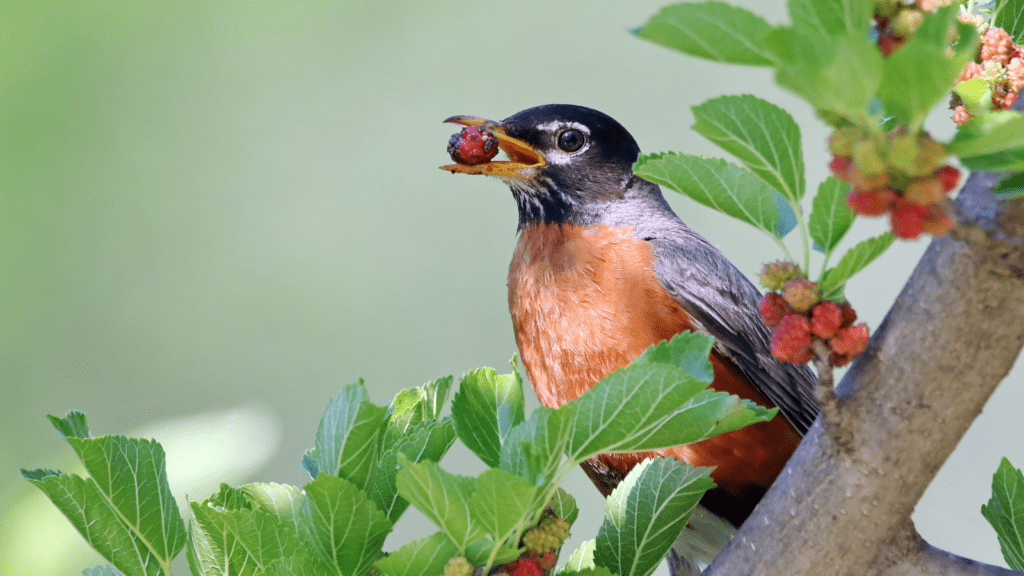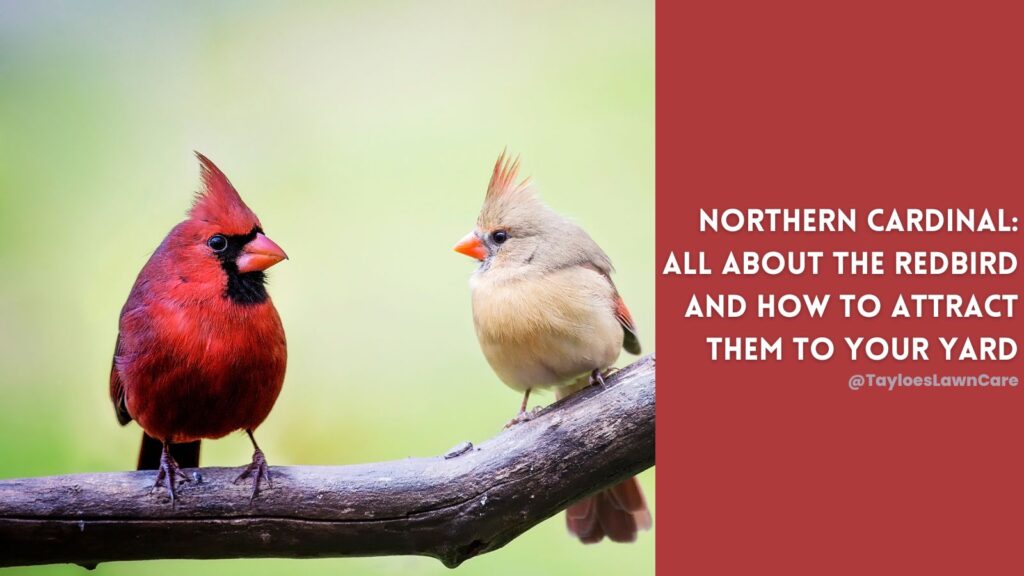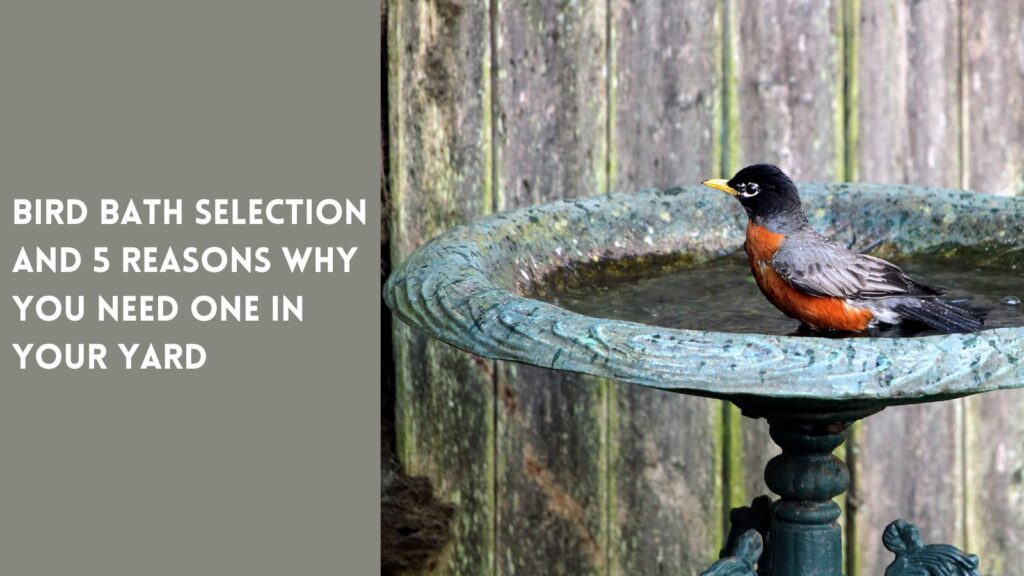Last Updated on: 29th December 2023, 02:12 pm
Robins are one of the earliest signs of springtime.
The American robin (Latin: Turdus migratorius) is a lovely feathered friend who makes an early-season appearance to welcome the warm temperatures of spring. This bird is a shining beacon of hope that the gray winter months will soon end and long, lazy summer days are imminent.
The American Robin is rich and deep brown; it sports a dark brown abdomen and tail and orange chest, often displaying a soft white speck. This bird is about eleven inches long, most famous as a songbird. Its eggs are aqua blue. Females can lay eggs up to three times yearly. Their favorite meals are grubs or worms, supplemented by various fruits and insects.
American robins live in open meadows, parks, and wooded suburbs. You might find them throughout the year in the United States; some migrate as far north as Alaska during the warmest days of summer.

8 Ways to Invite the American Robin Into Your Yard
Avid birdwatchers use binoculars to watch from a distance, allowing them to study birds without scaring them. However, you can watch robins in your backyard by creating a safe retreat for them. These birds are territorial by nature, so you might not attract more than a pair or two of mates, depending on your property’s size. That lovely springtime song signifies robins are “claiming” your property and telling other birds that this spot is off-limits! Here are the things you can do:
1 — Leave “Leaf Litter” Piles Around Your Yard
Female robins make cup-shaped nests from mud and natural materials when it is time to nest and lay eggs. She will search for twigs to weave the nest’s framework and leaves and grass to insulate the bottom and sides. This insulating layer helps her to keep her eggs warm until hatching.
Some birdwatchers estimate that it takes a mother robin and her mate over two hundred trips back and forth from the ground, from which she collects bits of materials, back to the nest. It might take her two weeks to finish making the nest. Note that while the male helps collect the materials, he protects the female as she does the nest building; he does not actively build the nest.
Her nest can be as large as 8″ in diameter when she finishes building it.
You can help a mama bird pick your yard by putting convenient “litter piles” out during nesting season (which occurs in spring). Preferably, you place these near a sturdy tree that attracts a bird who needs to make her nest.
Some materials to put out for her include:
- Small twigs (cut to under 6 inches long)
- Leaf debris
- Grass clippings
- Dryer lint
2 — Invest in Mealworms to Feed the American Robin
Robins enjoy the birdseed blends you put out for them. However, the species greatly benefit from adding some mealworms to the menu. Prepare the food mixture, add mealworms, and place it on a feeding ledge or near their usual feeding spot. You will attract a nice variety of birds to your offerings.
These birds should eat a diet of only 40% seeds and fruits but 60% worms, grubs, and insects. This balance is most important in the springtime when mama birds need nourishment to produce healthy hatchlings.
3 — Offer Your Feathered Friends These Fruits for a Varied Diet
The quality of the bird’s food determines its health status. So put a fruit dish on the feeding tray. Many different fruits attract these birds. It contains a large number of vitamins A, which is an essential nutrient for birds.
Here are a few fruits they appear to enjoy:
- Blueberries
- Mulberries
- Strawberries
- Tomatoes
- Cherries
- Apples
- Grapes
- Juniper berries
- Bell peppers
- Blackberries
- Raspberries
- Peaches
- Oranges
4 — Install a Protected Nesting Ledge
You can use a tree, a wall, or a fence to attach a nest ledge. A bare, sturdy pedestal with low sides to safely secure the nest and a basic roof to protect the mama bird from predators and poor weather will become a prime option for a bird looking to build a nest. However, you must remember that a robin’s nest can be relatively large, so a square of 12″ provides a spacious platform and becomes necessary if you want to attract this bird specifically.
Nothing in the world is quite as adorably lovely as a robin when he shows off and they are nearly always doing it.
Frances Hodgson Burnett
5 — Provide a Bird House or Two
Birds will use the housing you provide them for security, habitat, and laying eggs. By offering this haven, you too can befriend a robin family upon their arrival in the spring months. Once the mama bird lays her eggs, they hatch in about two weeks. After that, it takes the fledglings about two before they take flight.
Ecologists estimate that only about 25% of these birds survive to the age of six months due to predators. For that reason, young birds stay near their “home nest” and in their parents’ territory for another four months after leaving the parents’ nest. So if you provide a home, you expand a juvenile bird’s chances of maturing to adulthood.
6 — Grow Evergreen Shrubs for Early Spring Cover from Predators
Growing evergreen shrubs enhances the beauty of your yard and provides shelter and protection for your feathered friends. Shrubs with tightly packed limbs and strong branches provide an essential hiding place where birds can escape natural enemies like cats and larger birds of prey.
7 — The American Robin Prefers Ground Feeding or a Platform Feeder
Install a platform feeder instead of using a hanging feeder or perch feeder to attract these early springtime visitors.
Why do these lovely birds need this?
Many believe this species needs to root into the Earth for worms, beetles, grubs, and other protein sources, so they have a natural perching inclination. So placing a platform feeder in your feeding area will encourage this species to visit your yard.
8 — Give These Songbirds a Bird Bath to Enjoy
The feathered friends who come to the birdbath to bathe and quench their thirst are naturally attracted to your backyard. But a birdbath does more than provide birds with clean drinking water. It also provides a place to cool off on the hottest summer days and moisture to make mud for building their nests.
Please consider a birdbath with a solar fountain to keep the water moving steadily. Otherwise, it could stagnate and attract unwanted mosquitoes or cause algae to build up, harming some birds.
You, too, will enjoy the sounds, as nothing soothes the soul like a softly bubbling fountain.
The Takeaway: You Can Take Steps to Attract the American Robin and Enjoy Their Endearing Behaviors
If you enjoy birdwatching and nature, you’ll enjoy the cheery antics of robins dancing across your lawn, seeking food. The miracle of witnessing the diligent nest-building process is well worth the reward for doing these kinds of things to create a haven for these birds.
You will receive a bonus thanks to your kindness toward the American robin. Sharing your outdoor space with your new feathered friends will provide natural grub control for your lawn.
Don’t forget to follow us on Facebook @TayloesLawnCare for more yard beautification tips and info on getting maximum enjoyment from your outdoor spaces.
Author Profile

- Deborah Tayloe is the CEO and co-founder of Tayloe's Lawn Care Services, LLC. She has a B.S.Ed and holds certificates in soil and water management and herbology from accredited programs.
Latest entries
 Trees and ShrubsApril 22, 2025Boxwood Blight: Early identification and isolation
Trees and ShrubsApril 22, 2025Boxwood Blight: Early identification and isolation Flower GardenApril 8, 2025John F. Kennedy Rose: Hybrid tea rose with elegant white blooms
Flower GardenApril 8, 2025John F. Kennedy Rose: Hybrid tea rose with elegant white blooms Vegetable GardenMarch 24, 2025Trellis vegetables provide an abundant vertical garden harvest
Vegetable GardenMarch 24, 2025Trellis vegetables provide an abundant vertical garden harvest GardeningMarch 17, 2025Are coffee grounds good for compost?
GardeningMarch 17, 2025Are coffee grounds good for compost?






